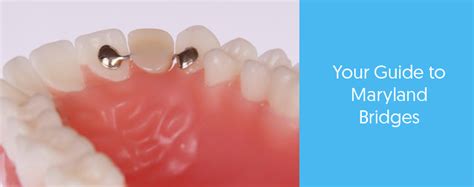What Is A Maryland Bridge

A Maryland bridge, also known as a resin-bonded bridge or Maryland bonded bridge, is a type of dental bridge that is used to replace a missing tooth. It is a conservative and cost-effective alternative to traditional dental bridges, which often require the adjacent teeth to be prepared with crowns.
The Maryland bridge consists of a porcelain or composite tooth attached to a metal wing or bracket, which is bonded to the back of the adjacent teeth using a tooth-colored resin cement. This design allows for a minimally invasive procedure, as the neighboring teeth do not need to be prepared or crowned.
Key Characteristics of a Maryland Bridge:
- Conservative Preparation: The Maryland bridge requires minimal preparation of the adjacent teeth, making it a more conservative option compared to traditional bridges.
- Resin-Bonded: The bridge is bonded to the adjacent teeth using a tooth-colored resin cement, which provides a strong and durable bond.
- Metal Wing: The metal wing or bracket is attached to the back of the adjacent teeth, providing additional support and stability to the bridge.
- Porcelain or Composite Tooth: The replacement tooth is made of porcelain or composite materials, which are designed to match the appearance and function of the natural tooth.
Advantages of a Maryland Bridge:
- Minimally Invasive: The procedure is less invasive, as the adjacent teeth do not need to be prepared or crowned.
- Cost-Effective: Maryland bridges are often less expensive than traditional bridges.
- Reversible: The bridge can be removed and replaced if needed, making it a reversible option.
- Aesthetic: The porcelain or composite tooth can be designed to match the appearance of the surrounding teeth, providing a natural-looking smile.
Disadvantages of a Maryland Bridge:
- Limited Durability: Maryland bridges may not be as durable as traditional bridges and may need to be replaced more frequently.
- Limited Load-Bearing Capacity: The bridge may not be able to withstand heavy chewing forces, which can lead to debonding or failure.
- Sensitivity: Some patients may experience sensitivity or discomfort after the procedure, which can be temporary or persistent.
Indications for a Maryland Bridge:
- Missing Tooth: A Maryland bridge is used to replace a single missing tooth, especially in the anterior (front) region.
- Aesthetic Concerns: The bridge is ideal for patients who want to improve the appearance of their smile and restore their confidence.
- Limited Budget: Maryland bridges are a cost-effective option for patients who cannot afford more expensive dental restorations.
Conclusion: A Maryland bridge is a conservative and cost-effective dental restoration option that can be used to replace a missing tooth. While it has its advantages, it also has limitations, and patients should discuss their individual needs and expectations with their dentist to determine if a Maryland bridge is the right choice for them.
What is the average cost of a Maryland bridge?
+The average cost of a Maryland bridge can range from 500 to 2,000, depending on the location, dentist, and materials used.
How long does a Maryland bridge last?
+A Maryland bridge can last for 5-15 years, depending on the quality of the bridge, oral hygiene, and chewing forces.
Can a Maryland bridge be used for multiple missing teeth?
+No, a Maryland bridge is designed to replace a single missing tooth. For multiple missing teeth, other dental restoration options, such as traditional bridges or implants, may be more suitable.

